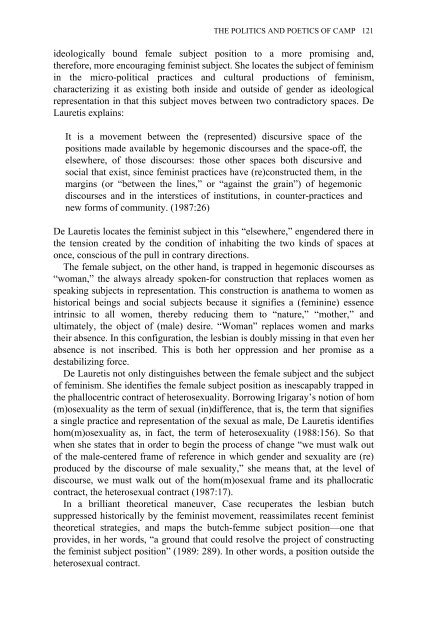Edited by Moe Meyer - Get a Free Blog
Edited by Moe Meyer - Get a Free Blog
Edited by Moe Meyer - Get a Free Blog
You also want an ePaper? Increase the reach of your titles
YUMPU automatically turns print PDFs into web optimized ePapers that Google loves.
THE POLITICS AND POETICS OF CAMP 121<br />
ideologically bound female subject position to a more promising and,<br />
therefore, more encouraging feminist subject. She locates the subject of feminism<br />
in the micro-political practices and cultural productions of feminism,<br />
characterizing it as existing both inside and outside of gender as ideological<br />
representation in that this subject moves between two contradictory spaces. De<br />
Lauretis explains:<br />
It is a movement between the (represented) discursive space of the<br />
positions made available <strong>by</strong> hegemonic discourses and the space-off, the<br />
elsewhere, of those discourses: those other spaces both discursive and<br />
social that exist, since feminist practices have (re)constructed them, in the<br />
margins (or “between the lines,” or “against the grain”) of hegemonic<br />
discourses and in the interstices of institutions, in counter-practices and<br />
new forms of community. (1987:26)<br />
De Lauretis locates the feminist subject in this “elsewhere,” engendered there in<br />
the tension created <strong>by</strong> the condition of inhabiting the two kinds of spaces at<br />
once, conscious of the pull in contrary directions.<br />
The female subject, on the other hand, is trapped in hegemonic discourses as<br />
“woman,” the always already spoken-for construction that replaces women as<br />
speaking subjects in representation. This construction is anathema to women as<br />
historical beings and social subjects because it signifies a (feminine) essence<br />
intrinsic to all women, there<strong>by</strong> reducing them to “nature,” “mother,” and<br />
ultimately, the object of (male) desire. “Woman” replaces women and marks<br />
their absence. In this configuration, the lesbian is doubly missing in that even her<br />
absence is not inscribed. This is both her oppression and her promise as a<br />
destabilizing force.<br />
De Lauretis not only distinguishes between the female subject and the subject<br />
of feminism. She identifies the female subject position as inescapably trapped in<br />
the phallocentric contract of heterosexuality. Borrowing Irigaray’s notion of hom<br />
(m)osexuality as the term of sexual (in)difference, that is, the term that signifies<br />
a single practice and representation of the sexual as male, De Lauretis identifies<br />
hom(m)osexuality as, in fact, the term of heterosexuality (1988:156). So that<br />
when she states that in order to begin the process of change “we must walk out<br />
of the male-centered frame of reference in which gender and sexuality are (re)<br />
produced <strong>by</strong> the discourse of male sexuality,” she means that, at the level of<br />
discourse, we must walk out of the hom(m)osexual frame and its phallocratic<br />
contract, the heterosexual contract (1987:17).<br />
In a brilliant theoretical maneuver, Case recuperates the lesbian butch<br />
suppressed historically <strong>by</strong> the feminist movement, reassimilates recent feminist<br />
theoretical strategies, and maps the butch-femme subject position—one that<br />
provides, in her words, “a ground that could resolve the project of constructing<br />
the feminist subject position” (1989: 289). In other words, a position outside the<br />
heterosexual contract.


